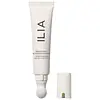What's inside
What's inside
 Key Ingredients
Key Ingredients

 Benefits
Benefits

 Concerns
Concerns

 Ingredients Side-by-side
Ingredients Side-by-side

Ethylhexyl Methoxycinnamate 5%
UV AbsorberTitanium Dioxide 3.2%
Cosmetic ColorantZinc Oxide 3.6%
Cosmetic ColorantWater
Skin ConditioningDimethicone
EmollientButyloctyl Salicylate
Skin ConditioningIsononyl Isononanoate
EmollientNeopentyl Glycol Diheptanoate
EmollientLauryl PEG-9 Polydimethylsiloxyethyl Dimethicone
Skin ConditioningButylene Glycol
HumectantPolydecene
Skin ConditioningPolyhydroxystearic Acid
EmulsifyingEthylhexyl Methoxycrylene
Skin ConditioningHydrated Silica
AbrasiveDimethicone/Vinyl Dimethicone Crosspolymer
Skin ConditioningTrimethylsiloxysilicate
EmollientHydrolyzed Wheat Protein/Pvp Crosspolymer
Hydroxyapatite
AbrasiveCetyl PEG/PPG-10/1 Dimethicone
EmulsifyingDimethicone/PEG-10/15 Crosspolymer
Sodium Rna
Skin ConditioningQuaternium-90 Bentonite
Sodium Hyaluronate
HumectantDimethicone Crosspolymer-3
Skin ConditioningStyrene/Acrylates Copolymer
Sodium Chloride
MaskingCaprylyl Glycol
EmollientPEG-8 Laurate
EmulsifyingPropylene Carbonate
SolventSilica
AbrasiveTocopherol
AntioxidantSodium Citrate
BufferingDisodium EDTA
BHT
AntioxidantPhenoxyethanol
PreservativePotassium Sorbate
PreservativeCI 77491
Cosmetic ColorantCI 77492
Cosmetic ColorantEthylhexyl Methoxycinnamate 5%, Titanium Dioxide 3.2%, Zinc Oxide 3.6%, Water, Dimethicone, Butyloctyl Salicylate, Isononyl Isononanoate, Neopentyl Glycol Diheptanoate, Lauryl PEG-9 Polydimethylsiloxyethyl Dimethicone, Butylene Glycol, Polydecene, Polyhydroxystearic Acid, Ethylhexyl Methoxycrylene, Hydrated Silica, Dimethicone/Vinyl Dimethicone Crosspolymer, Trimethylsiloxysilicate, Hydrolyzed Wheat Protein/Pvp Crosspolymer, Hydroxyapatite, Cetyl PEG/PPG-10/1 Dimethicone, Dimethicone/PEG-10/15 Crosspolymer, Sodium Rna, Quaternium-90 Bentonite, Sodium Hyaluronate, Dimethicone Crosspolymer-3, Styrene/Acrylates Copolymer, Sodium Chloride, Caprylyl Glycol, PEG-8 Laurate, Propylene Carbonate, Silica, Tocopherol, Sodium Citrate, Disodium EDTA, BHT, Phenoxyethanol, Potassium Sorbate, CI 77491, CI 77492
Water
Skin ConditioningCaprylic/Capric Triglyceride
MaskingPersea Gratissima Oil
Skin ConditioningPropanediol
SolventGlycerin
HumectantPentylene Glycol
Skin ConditioningCetearyl Alcohol
EmollientCandelilla/Jojoba/Rice Bran Polyglyceryl-3 Esters
EmulsifyingJojoba Oil/Macadamia Seed Oil Esters
Skin ConditioningBrassica Campestris/Aleurites Fordi Oil Copolymer
Skin ConditioningSilica
AbrasiveGlyceryl Stearate
EmollientSodium Polyacryloyldimethyl Taurate
Emulsion StabilisingBehenyl Alcohol
EmollientCaffeine
Skin ConditioningMoringa Oil/Hydrogenated Moringa Oil Esters
Skin ConditioningSodium Stearoyl Lactylate
EmulsifyingMica
Cosmetic ColorantHydroxyacetophenone
AntioxidantCaprylyl Glycol
Emollient1,2-Hexanediol
Skin ConditioningSqualene
EmollientCaprylic/Capric/Succinic Triglyceride
EmollientXanthan Gum
EmulsifyingCitric Acid
BufferingSodium Phytate
Phytosteryl Macadamiate
Skin ConditioningPersea Gratissima Fruit Extract
EmollientCrithmum Maritimum Extract
Skin ConditioningPhytosterols
Skin ConditioningTocopherol
AntioxidantAcetyl Hexapeptide-8
HumectantSodium Citrate
BufferingCI 77891
Cosmetic ColorantCI 77491
Cosmetic ColorantWater, Caprylic/Capric Triglyceride, Persea Gratissima Oil, Propanediol, Glycerin, Pentylene Glycol, Cetearyl Alcohol, Candelilla/Jojoba/Rice Bran Polyglyceryl-3 Esters, Jojoba Oil/Macadamia Seed Oil Esters, Brassica Campestris/Aleurites Fordi Oil Copolymer, Silica, Glyceryl Stearate, Sodium Polyacryloyldimethyl Taurate, Behenyl Alcohol, Caffeine, Moringa Oil/Hydrogenated Moringa Oil Esters, Sodium Stearoyl Lactylate, Mica, Hydroxyacetophenone, Caprylyl Glycol, 1,2-Hexanediol, Squalene, Caprylic/Capric/Succinic Triglyceride, Xanthan Gum, Citric Acid, Sodium Phytate, Phytosteryl Macadamiate, Persea Gratissima Fruit Extract, Crithmum Maritimum Extract, Phytosterols, Tocopherol, Acetyl Hexapeptide-8, Sodium Citrate, CI 77891, CI 77491
Ingredients Explained
These ingredients are found in both products.
Ingredients higher up in an ingredient list are typically present in a larger amount.
Caprylyl Glycol is a humectant and emollient, meaning it attracts and preserves moisture.
It is a common ingredient in many products, especially those designed to hydrate skin. The primary benefits are retaining moisture, skin softening, and promoting a healthy skin barrier.
Though Caprylyl Glycol is an alcohol derived from fatty acids, it is not the kind that can dry out skin.
This ingredient is also used as a preservative to extend the life of products. It has slight antimicrobial properties.
Learn more about Caprylyl GlycolCi 77491 is also hydrated iron III oxide. It's sole purpose is to give a red/pink hue to products.
Iron III oxides are classified as inorganic chemicals for coloring.
Synthetically created Ci 77491 is considered safer than those naturally found. This is because the synthetically created version may contain less impurities. Iron oxides are generally non-toxic and non-allergenic.
Learn more about CI 77491Silica, also known as silicon dioxide, is a naturally occurring mineral. It is used as a fine, spherical, and porous powder in cosmetics.
Though it has exfoliant properties, the function of silica varies depending on the product.
The unique structure of silica enhances the spreadability and adds smoothness, making it a great texture enhancer.
It is also used as an active carrier, emulsifier, and mattifier due to its ability to absorb excess oil.
In some products, tiny microneedles called spicules are made from silica or hydrolyzed sponge. When you rub them in, they lightly polish away dead skin layers and enhance the penetration of active ingredients.
Learn more about SilicaSodium Citrate is the sodium salts of citric acid. In skincare, it is used to alter pH levels and acts as a preservative.
Its main functions are to maintain the pH of a product and neutralize metal ions.
The acidity of our skin is maintained by our glands and skin biome; normal pH level of skin is slightly acidic (~4.75-5.5).
Being slightly acidic allows our skin to create an "acid mantle". This acid mantle is a thin barrier that protects our skin from bacteria and contaminants.
Learn more about Sodium CitrateTocopherol (also known as Vitamin E) is a common antioxidant used to help protect the skin from free-radicals and strengthen the skin barrier. It's also fat soluble - this means our skin is great at absorbing it.
Vitamin E also helps keep your natural skin lipids healthy. Your lipid skin barrier naturally consists of lipids, ceramides, and fatty acids. Vitamin E offers extra protection for your skin’s lipid barrier, keeping your skin healthy and nourished.
Another benefit is a bit of UV protection. Vitamin E helps reduce the damage caused by UVB rays. (It should not replace your sunscreen). Combining it with Vitamin C can decrease sunburned cells and hyperpigmentation after UV exposure.
You might have noticed Vitamin E + C often paired together. This is because it is great at stabilizing Vitamin C. Using the two together helps increase the effectiveness of both ingredients.
There are often claims that Vitamin E can reduce/prevent scarring, but these claims haven't been confirmed by scientific research.
Learn more about TocopherolWater. It's the most common cosmetic ingredient of all. You'll usually see it at the top of ingredient lists, meaning that it makes up the largest part of the product.
So why is it so popular? Water most often acts as a solvent - this means that it helps dissolve other ingredients into the formulation.
You'll also recognize water as that liquid we all need to stay alive. If you see this, drink a glass of water. Stay hydrated!
Learn more about Water